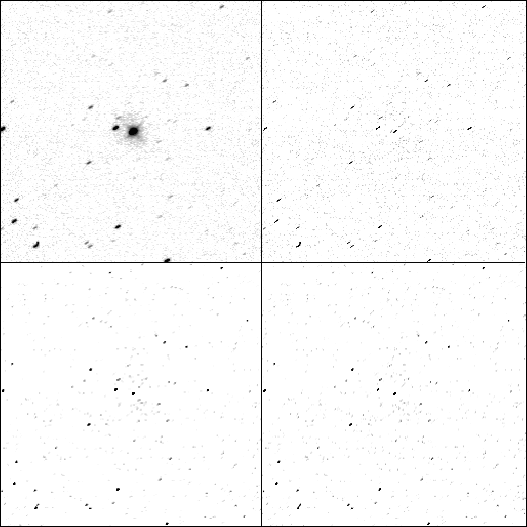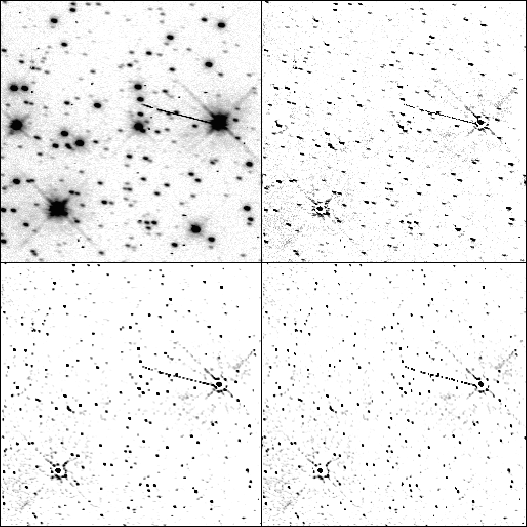




 1208 kB PostScript reprint
1208 kB PostScript reprint
Next: MEM Task for
Up: Image Restoration and
Previous: RegisteringPSF-Matching and
Astronomical Data Analysis Software and Systems IV
ASP Conference Series, Vol. 77, 1995
Book Editors: R. A. Shaw, H. E. Payne, and J. J. E. Hayes
Electronic Editor: H. E. Payne
J. Mo and R. J. Hanisch
Space Telescope Science Institute, 3700 San Martin
Drive, Baltimore, MD 21218
Operated by AURA, Inc., for NASA
Abstract:
In gyro-hold tracking mode, HST is stabilized only with its gyros, and the
Fine Guidance Sensors are not used to maintain pointing. With gyro drift
rates of order 0.'' 002 per second of time, a WFPC 2 Planetary Camera
image with a typical exposure time of 100 s can be blurred by as much
as five pixels. Image restoration techniques developed for use on aberrated
HST images have been adapted for use to remove this motion blur.
Experiments have been done on WFPC 2 images of NGC 330 and NGC 422 (having
exposure times of 80 and 100 s in gyro-hold mode) with complete
success.
Since the first servicing mission in 1993 December, HST's optical performance
has been corrected to nearly the original design specifications. As a result,
however, spacecraft stability and the guiding mode used by the Fine Guidance
Sensors (FGSs)
have become much more significant factors in determining overall image
quality. The FGSs now have only two guiding modes: fine lock and gyro-hold.
In order to utilize gaps in the HST observing program that would otherwise be
unused, about 200--300 ``snapshot'' observations are placed on the program in
each observing cycle. In order to minimize spacecraft overhead, snapshot
observations are taken without guiding, using gyro pointing control only (e.g.,
Bond 1994). Gyro-hold pointing drifts at a rate ah high as  mas
s
mas
s . This motion causes a significant blur in WFPC 2 images, even for
exposures as short as 100s. Given our experience in restoring the
aberrated images from WFPC 1, we decided to explore the possibilities of
removing the motion blur from images taken in gyro-hold pointing mode with
WFPC 2.
. This motion causes a significant blur in WFPC 2 images, even for
exposures as short as 100s. Given our experience in restoring the
aberrated images from WFPC 1, we decided to explore the possibilities of
removing the motion blur from images taken in gyro-hold pointing mode with
WFPC 2.
Two WFPC 2 snapshot observations of NGC 422 and NGC 330 (kindly provided
by M. Shara) have been restored successfully using the image restoration
techniques which have been implemented in the STSDAS package.
An NGC 422 WFPC 2 WC2 image and an NGC 330 WFPC 2 PC1 image were taken in mode
FSGLOCK = GYROS in 1994 January. A synopsis of these
images is given in Table 1. In the table, the column ``Image Section''
indicates the pixel coordinates of the detector in the sequence  . The restorations have each been
done on a
. The restorations have each been
done on a  pixel subimage.
pixel subimage.

Table: WFPC 2 Images
The restoration of the motion blurred images is carried out in three
stages: (1) standard restoration using a model PSF, (2) determination of the
motion-blur function, and (3) final restoration. The initial model PSFs were
computed using Tiny TIM Version 4.0. For each observation, the PSF position
coincides with the peak position of a bright star.

Figure: WFPC 2 image of NGC 422 (WF2, exposure = 100 s). Top left: original
observation.
Top right: standard Tiny TIM deconvolution. Bottom left: MEM restoration
(final). Bottom right: Lucy restoration (final).
Original PostScript figure (541 kB)
In order to generate the motion-blur function, a standard Tiny TIM PSF
restoration is made for each observation. The blurring function is determined
by averaging the images of several bright stars in the initial restored frame.
The final PSF is constructed by convolving the motion blur function with the
Tiny TIM PSFs.
The restorations were done using the maximum entropy method (MEM) (Wu 1992, 1994)
as implemented in STSDAS.
The restored image adopted is the ME solution after
approximately 100 iterations. The Richardson-Lucy method has also been tested
in this experiment using the task lucy implemented in STSDAS (White 1993;
Stobie et al. 1994).
The motion-blurred images of NGC 422 and NGC 330, and their restorations are
illustrated in Figs. 1 and 2, respectively.

Figure: NGC 330 WFPC 2 (PC1, exposure = 80 s). Top left: original
observation.
Top right: standard Tiny TIM deconvolution. Bottom left: MEM restoration
(final). Bottom right: Lucy restoration (final).
Original PostScript figure (541 kB)
The point spread function for data taken in gyro-hold mode is the
convolution of the normal PSF with the motion blurring function. Because
our PSF models are now quite accurate, deconvolution of a motion-blurred
image with a model PSF yields an image in which the remaining shapes,
and features associated with point sources, define the motion-blur component.
This residual also
encompasses any additional mismatches between the model PSF and the
observed PSF in the absence of motion blur.
WFPC 2 is undersampled, especially in the UV in WF mode. In order to
obtain a better representation of the motion blurring function, several
(partially) restored star images are averaged together. The success of
the method relies upon having several bright but unsaturated star images
in the field of view.
Our experiments indicate that gyro drift is not uniform linear motion, but
rather must be described by a two-dimensional function. Indeed, the final PSF
obtained for the NGC 422 image shows a multiply-peaked structure, indicating
that within the exposure time the telescope dwelled longer at certain locations
than in others. A surface plot of this PSF and the final PSF of the NGC 330
image are shown in Figure 3. Both the MEM and Richardson-Lucy
algorithms implemented in STSDAS were successful in restoring the image with a
multiply-peaked PSF, and gave virtually indistinguishable results.
The standard image restoration techniques developed for use on aberrated
HST images can be adapted for removing the motion blur from snapshot
images taken under gyro-hold pointing mode. This should allow observers to
obtain optimal spatial resolution and dynamic range on many of these data sets.

Figure: Motion-blurred PSF. Left: PSF of NGC 422 WFPC 2
(WF2, exposure = 100 s). Right: NGC 330 WFPC 2 (PC1, exposure = 80 s).
Original PostScript figure (77 kB)
Acknowledgments:
Support from ST ScI's Image Restoration Project, funded by NASA as a contract
augmentation to NAS5--26555, is gratefully acknowledged. The authors thank
M. Shara for providing his HST WFPC2 observations prior to publication.
References:
Bond, H. E., ed. 1994, Hubble Space Telescope Cycle 5 Call for
Proposals (Baltimore, Space Telescope Science Institute)
Stobie, E. B., Hanisch, R. J., & White, R. L. 1994,
in Astronomical Data Analysis Software and Systems III, ASP Conf. Ser., Vol. 61, eds. D. R. Crabtree, R. J. Hanisch, & J. Barnes (San Francisco, ASP), p. 296





 1208 kB PostScript reprint
1208 kB PostScript reprint
Next: MEM Task for
Up: Image Restoration and
Previous: RegisteringPSF-Matching and
adass4_editors@stsci.edu
 mas
s
mas
s . This motion causes a significant blur in WFPC 2 images, even for
exposures as short as 100s. Given our experience in restoring the
aberrated images from WFPC 1, we decided to explore the possibilities of
removing the motion blur from images taken in gyro-hold pointing mode with
WFPC 2.
. This motion causes a significant blur in WFPC 2 images, even for
exposures as short as 100s. Given our experience in restoring the
aberrated images from WFPC 1, we decided to explore the possibilities of
removing the motion blur from images taken in gyro-hold pointing mode with
WFPC 2.
 . The restorations have each been
done on a
. The restorations have each been
done on a  pixel subimage.
pixel subimage.



